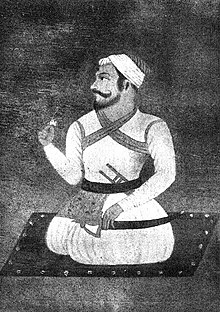Capture of Tengenapatam
This article does not have any categories. Please add a category so that it will be placed in a dynamic list with other articles like it. (December 2024) |
On 15 December 1660 the Bijapur Commadar Shahaji led siege to the Fort of Tengenapatam (now Nagapattinam) with 200 of his men Governer Pitt send a force of 3000 men but they were unable to defeat the Bijapuri army.[1][2][3]
| Capture of Tengenapatam (1661) | |||||||||
|---|---|---|---|---|---|---|---|---|---|
| Part of Bijapur Expansion | |||||||||
| |||||||||
| Belligerents | |||||||||
| Bijapur Sultanate |
| ||||||||
| Commanders and leaders | |||||||||
| Shahaji |
| ||||||||
| Strength | |||||||||
| 200 Marathas | 3000 men | ||||||||

Battle
changeOn 15th December 1660, the people of Shahaji laid siege to the town of Tegenapatam, causing the Dutch Company's operations there to come to a halt. Despite this, the residents remained hopeful that they would be able to prepare 200 bales of carpets for shipment to Batavia by mid-February 1662.[1][2]
Additionally, we observe from the letter written by Governor Pit to Seylon :[1]
Sahagie's men have looted the town Carcal a few days before the letter was closed and that they had robbed the inhabitants of not less than 1,700 pardaux. Although he was short of cash, the Governor has sent 3,000 pardaux to Negapatnam to pay the garrison there. The war round the fort Tegenapatnam is finished and the fort has been delivered to Sahagie's men on the 4th February 1661, so that Tegenepatnam and the premises of the Company there are now under the command of Sahagie. This looks serious, but the Governor does not believe that he will trouble us, because he is aware that the Company can rely on the strong forces at Porto Novo, which would make his profits useless. It would be possible to transfer the trade to Poolesere (Phulchari or Pondichery), about 4 miles from Tegenapatnam, and to leave the premises at Tegenapatnam under the supervision of an assistant and 3 or 4 soldiers, but the merchants would not dare come out of fear for Sahagie; and Kistapaneyak, (Krishnappa Nayak) who is an upper-regent of Poolesere on behalf of Mir Jumla, would not be able to protect us against him, so that discharging cargo at Paelesere would only cause trouble to the Company, "
— Governor Pitt
References
change- ↑ 1.0 1.1 1.2 Shivaji The Great 1 ( Dr. Balkrishna). p. 146.
- ↑ 2.0 2.1 B. Muddachari. Mysore-Maratha Relations Under Shahji, Shivaji, Sambhaji And Rajaram (As Revealed In Kannada Sources).
- ↑ B. Muddhachari (1965-05-04). The Mysore-Maratha Relations in the 17th Century.